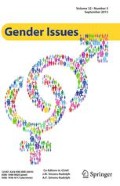Abstract
Physical attractiveness has been known to act as a cue in determining perceptions of other individuals. Possession of a positive characteristic, such as attractiveness, results in a positive cognitive bias towards the individual. Similarly, possession of a negative characteristic, such as unattractiveness, results in the opposite effect. In addition to unattractiveness, the violation of social norms has been known to act as a cue for this negative bias. This experiment sought to examine how male facial attractiveness interacted with norm violation to alter females’ perceptions of males. Two male faces (attractive and unattractive) bearing similar features were paired with two scenarios of norm violation (high violation and low violation) while being rated on perceived personality characteristics. It was expected that halo/devil effects would occur based on facial attractiveness, and that norm violation would produce a devil effect in the men. An interaction effect between the two was also expected. Participants were 170 female college students. Results were analyzed using a repeated ANOVA and independent t tests. Findings show that a “double” devil effect occurred with the unattractive high violation condition. Norm violation also presented significant results, while facial attractiveness alone did not. Findings pose implications for online dating and jury deliberations.
References
Brand, R., Bonatsos, A., D’Orazio, R., & DeShong, H. (2012). What is beautiful is good, even online: Correlations between photo attractiveness and text attractiveness in men’s online dating profiles. Computers in Human Behavior, 28(1), 166–170.
Brauer, M., & Chekroun, P. (2005). The relationship between perceived violation of social norms and social control: Situational factors influencing the reaction to deviance. Journal of Applied Social Psychology, 35, 1519–1539.
Buss, D. (1989). Sex differences in human mate preferences: Evolutionary hypotheses tested in 37 cultures. Behavioral and Brain Sciences, 12(1), 1–49.
Chantal, Y., Bernache-Assollant, I., & Schiano-Iomoriello, S. (2013). Examining a negative halo effect to anabolic steroids users through perceived achievement goals, sportspersonship orientations, and aggressive tendencies. Scandinavian Journal of Psychology, 54, 173–177.
DeSantis, A., & Kayson, W. (1997). Defendants’ characteristics of attractiveness, race, and sex and sentencing decisions. Psychological Reports, 81(2), 679–683.
Dion, K. (1972). Physical attractiveness and evaluation of children’s transgressions. Journal of Personality and Social Psychology, 24, 207–213.
Dion, K. (1973). Young children’s stereotyping of facial attractiveness. Developmental Psychology, 9, 183–188.
Dion, K., Berscheid, E., & Walster, E. (1972). What is beautiful is good. Journal of Personality and Social Psychology, 24, 285–290.
Dooley, D., & Gliner, J. (1989). Perception of disability labels: Effect of attitude and stimulus presentation. Rehabilitation Psychology, 34(4), 259–270.
Downs, C., & Lyons, P. (1991). Natural observations of the links between attractiveness and initial legal judgment. Personality and Social Psychology Bulletin, 17, 541–547.
Esses, V., & Webster, C. (1988). Physical attractiveness, dangerousness, and the Canadian criminal code. Journal of Applied Social Psychology, 18, 1017–1031.
Ha, T., Berg, J., Engels, R., & Lichtwarck-Aschoff, A. (2012). Effects of attractiveness and status in dating desire in homosexual and heterosexual men and women. Archives of Sexual Behavior, 41(3), 673–682.
Ha, T., Overbeek, G., & Engels, R. (2010). Effects of attractiveness and social status on dating desire in heterosexual adolescents: An experimental study. Archives of Sexual Behavior, 39(5), 1063–1071.
Kaplan, R. (1978). Is beauty talent? Sex interaction in the attractiveness halo effect. Sex Roles, 4, 195–204.
Kruger, D. (2006). Male facial masculinity influences attributions of personality and reproductive strategy. Personal Relationships, 13, 451–463.
Larose, H., & Standing, L. (1998). Does the halo effect occur in the elderly? Social Behavior and Personality, 26, 147–150.
Lyman, B., Hatlelid, D., & Macurdy, C. (1981). Stimulus-person cues in first-impression attraction. Perceptual and Motor Skills, 52, 59–66.
Macapagal, K., Rupp, H., & Heiman, J. (2011). Influences of observer sex, facial masculinity, and gender role identification on first impressions of men’s faces. Journal of Social, Evolutionary, and Cultural Psychology, 5, 92–105.
Miller, A. (1970). Role of physical attractiveness in impression formation. Psychonomic Science, 19, 241–243.
Nisbett, R., & Wilson, T. (1977). The halo effect: Evidence for unconscious alteration of judgments. Journal of Personality and Social Psychology, 35, 250–256.
Quist, M., Watkins, C., Smith, F., Little, A., DeBruine, L., & Jones, B. (2012). Sociosexuality predicts women’s preferences for symmetry in men’s faces. Archives of Sexual Behavior, 41, 1415–1421.
Shifrer, D. (2013). Stigma of a label: Educational expectations for high school students labeled with learning disabilities. Journal of Health and Social Behavior, 54(4), 462–480.
Smith, E., & Hed, A. (1979). Effects of offenders’ age and attractiveness on sentencing by mock juries. Psychological Reports, 44(3, Pt 1), 691–694.
Sritharan, R., Heilpern, K., Wilbur, C., & Gawronski, B. (2010). I think I like you: Spontaneous and deliberate evaluations of potential romantic partners in an online dating context. European Journal of Social Psychology, 40(6), 1062–1077.
Thorndike, E. (1920). A constant error on psychological rating. Journal of Applied Psychology, 4, 25–29.
Tidwell, N., Eastwick, P., & Finkel, E. (2013). Perceived, not actual, similarity predicts initial attraction in a live romantic context: Evidence from the speed-dating paradigm. Personal Relationships, 20, 199–215.
Weisbuch, M., Ambady, N., Clarke, A., Achor, S., & Weele, J. (2010). On being consistent: The role of verbal-nonverbal consistency in first impressions. Basic and Applied Social Psychology, 32, 261–268.
Wenegrat, B., Abrams, L., Castillo-Yee, E., & Romine, I. (1996). Social norm compliance as a signaling system: I. Studies of fitness-related attributions consequent on everyday norm violations. Ethology & Sociobiology, 17, 403–416.
Willis, J., & Todorov, A. (2006). First impressions: Making up your mind after a 100-ms Exposure to a Face. Psychological Science, 17, 592–598.
Zahavi, A. (1975). Mate selection—A selection for a handicap. Journal of Theoretical Biology, 53, 205–214.
Author information
Authors and Affiliations
Corresponding author
Rights and permissions
About this article
Cite this article
Gibson, J.L., Gore, J.S. You’re OK Until You Misbehave: How Norm Violations Magnify the Attractiveness Devil Effect. Gend. Issues 32, 266–278 (2015). https://doi.org/10.1007/s12147-015-9142-5
Published:
Issue Date:
DOI: https://doi.org/10.1007/s12147-015-9142-5

